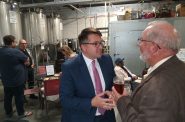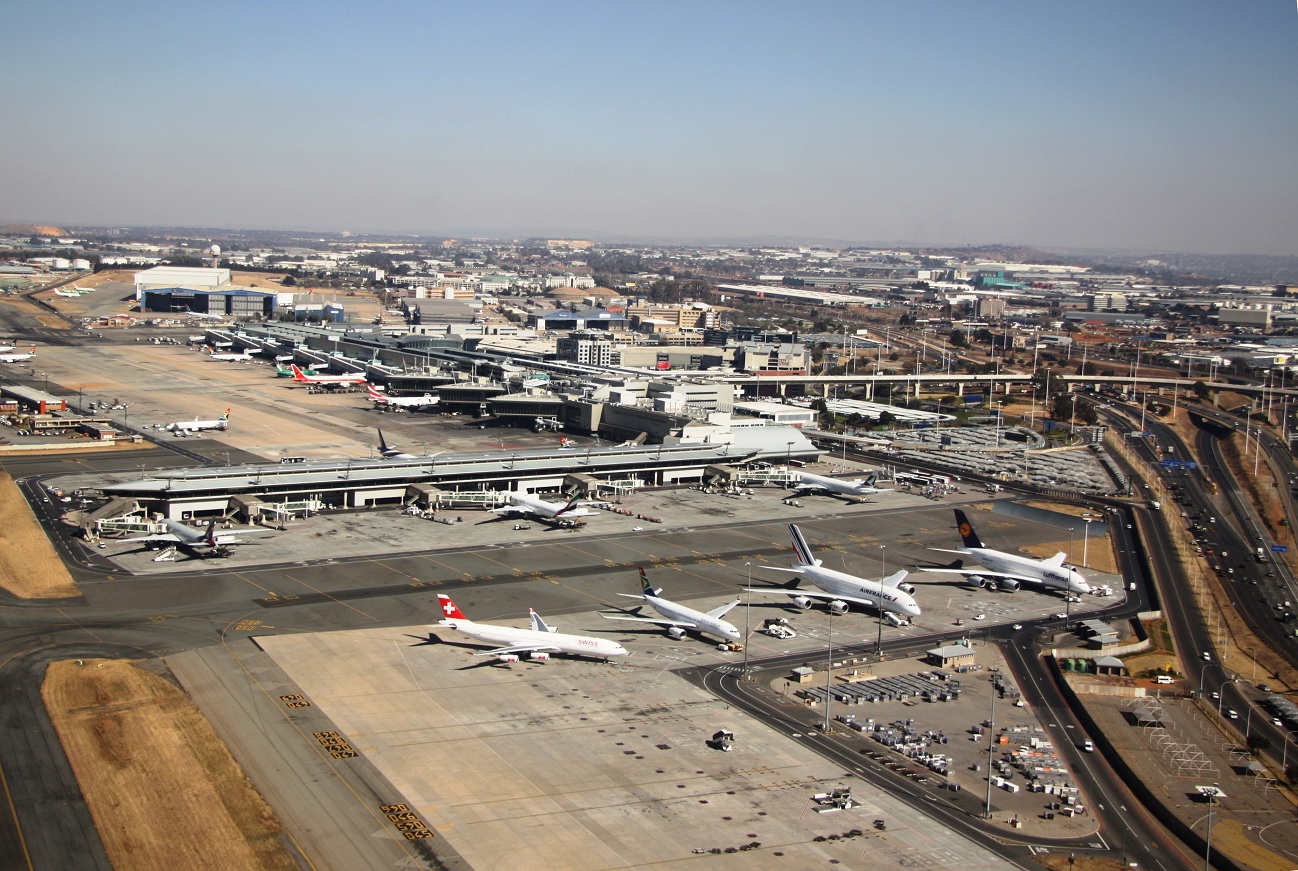Does Milwaukee Need an Aerotropolis?
Many cities have embraced concept of airport centered growth. Is Milwaukee falling behind?
Once again, poor old Milwaukee is far behind behind many cities. So says Tom Rave, the recently retired executive director of the Milwaukee Gateway Aerotropolis Corp., a non-profit group that was set up to promote the idea of an “aerotropolis” — airport-centered urban growth that’s occurring on a world-wide basis.
“When one is as far behind as our area is on a comparative basis, it will be tough to catch up and if that’s all that people want, they won’t ever catch up because other areas keep on improving,” Rave warns. “There are over 35 other aerotropolis developments going on in the U.S. Some significant changes need to be made here – or else.”
The man who coined the term “aerotropolis” is University of North Carolina business school professor John Kasarda, whose co-authored book, called Aerotropolis (what else?) has gotten a lot of buzz. Time magazine named Aerotropolis “One of the Ten Ideas that Will Change the World,” while Future Cities magazine named Kasarda among “The Top 100 City Innovators Worldwide.”
“An aerotropolis is basically an airport-integrated region, extending as far as sixty miles from the inner clusters of hotels, offices, distribution, and logistics facilities,” Kasarda has explained. “Airports are now effectively a part of global production systems and without that connectivity, you’re out of the game.”
But it needn’t work that way. The other way to look at is that aerotropolis simply involves making sure all your transportation infrastructure — freeways, roads, trains, the Port of Milwaukee — are all connected as efficiently as possible to Mitchell International Airport, given that airport travel is how the whole world makes connections. Seen that way, the creation of an Amtrak stop at the airport was a step forward that helped connect Milwaukee and Chicago to our airport. And Gov. Scott Walker’s decision to turn down federal funding for high-speed rail was a step backward, blowing the opportunity to better connect Madison and the Twin Cities to Milwaukee’s airport.
Indeed the concept of an aerotropolis, buzzword or not, presents an opportunity to gain federal funding to help build infrastructure in Milwaukee. Memphis won a $1.2 million grant to help build an aerotropolis. Denver got a $500,000 federal grant for its effort. Detroit gained $260,880 and San Diego snagged $40,000.
By contrast, Wisconsin has become the state that turns down federal funding, whether for high speed rail or expansion of Medicaid.
Walker’s “Transform Milwaukee” initiative, which has promised $100 million for metro area projects, includes aerotropolis as one of the projects, but to date has provided no funding for it. The Wisconsin Housing and Economic Development Agency, which oversees Transform Milwaukee, did a report that included minimal discussion of the aerotropolis concept.
The picture locally looks even worse. True, nine local governments have signed an inter-local cooperation agreement to work with the Milwaukee Gateway group, including Milwaukee, St. Francis, Cudahy, South Milwaukee, Oak Creek, Franklin, Greendale, Greenfield and Hales Corners. At least five of these governments own at least part of the land on which the airport is located, so their cooperation is important.
But Rave says the chronic squabbles between area governments in the region make collaboration difficult, if not impossible. In particular, he says, Milwaukee County, which runs the airport, presents a problem. County board members, he says, have adopted a “defensive position” and see any effort at regional cooperation as “an attempt to take over the airport” from them.
Longtime and well-regarded Mitchell airport director Barry Bateman has retired and the county is in the process of hiring a new director. Rave says the county pay structure likely means it will offer a salary that’s below pay for airport directors nationally.
Milwaukee County Executive Chris Abele says his administration is “getting close to hiring a new airport director. One of the things we looked at was finding someone with experience with economic development.”
Rave’s group hired Kasarda to create a strategic plan for a Milwaukee aerotropolis and Abele attended a talk by the professor. Abele compares Kasarda to the wily salesman in The Music Man, peddling a gimmick that is simply a different way of looking at “strategically leveraging everything around an airport.”
Kasarda has attracted criticism from others, including writer Rowan Moore, who did a story for The Guardian calling aerotropolis a “soul-less” model of a city “driven by a combination of business imperatives and state control, with the high levels of security and control that go with airports. Under the dictatorship of speed, individual memory and identity are abolished… and spontaneity and initiative are abolished.”
Whew. Fortunately, Milwaukee has made so little progress on the aerotropolis idea there’s no need for such heavy philosophic concerns. The more pressing issue is whether we can simply do a better job of strategically connecting all transportation modes.
The aerotropolis idea in Milwaukee goes back to 2009, yet there has been almost no coverage of this in the media. (My colleague Jeramey Jannene did a thoughtful piece back in 2011.)
The Milwaukee 7 regional business group officially supports the idea, but when I asked its executive director Pat O’Brien who is driving the aerotropolis effort, he answered “I’m not sure.” The effort gets about one page of discussion in an 81-page M7 report called “Framework for Economic Growth”
Retirement has perhaps allowed Rave to be more frank about the problems he faced. (His successor James Tarantino, hasn’t given an interview to the press to date.) Rave says his group hired the Parsons Brinkerhoff engineering and consulting group to help it make more progress. But he says what’s really needed is a regional transportation group of some kind that could apply for federal funding or even private equity investments. The question that arises from any potential funders, he says, is “who is the entity we would work with?”
But efforts to create a regional transportation authority were resisted by some county officials and killed by the state legislature. Even before the state became so divided politically, regional was a dirty word. That’s the bad news. The good news: no one need have any sleepless nights about a soul-less, Big Brother aerotropolis taking over southeastern Wisconsin.
Murphy's Law
-
National Media Discovers Mayor Johnson
 Jul 16th, 2024 by Bruce Murphy
Jul 16th, 2024 by Bruce Murphy
-
Milwaukee Arts Groups in Big Trouble
 Jul 10th, 2024 by Bruce Murphy
Jul 10th, 2024 by Bruce Murphy
-
The Plague of Rising Health Care Costs
 Jul 8th, 2024 by Bruce Murphy
Jul 8th, 2024 by Bruce Murphy
Plenty of Horne
-
Villa Terrace Will Host 100 Events For 100th Anniversary, Charts Vision For Future
 Apr 6th, 2024 by Michael Horne
Apr 6th, 2024 by Michael Horne
-
Notables Attend City Birthday Party
 Jan 27th, 2024 by Michael Horne
Jan 27th, 2024 by Michael Horne
-
Will There Be a City Attorney Race?
 Nov 21st, 2023 by Michael Horne
Nov 21st, 2023 by Michael Horne























I don’t get it.
How is a $500,000 Federal grant going to do anything? Just one terminal at Dubia’s new airport cost $9 billion dollars. It wouldn’t even pay for the men’s bathrooms in that building. The whole cost of the project has been put upwards to $150 billion.
Also, you might remember GM’s vision of the future at the 1939 World’s Fair looked very much like an Aerotropolis. This future is really just the past’s fantasy of the future that never happened for many very good reasons. One being — who would want to live there?
-Bruce writes: For years, Milwaukee has referred to Mitchell as “Chicago’s third airport” and has had some success attracting customers from Northern Illinois. But if this new airport is built and offers quicker connections, Milwaukee will lose business.
Would that many people from Northern Illinois prefer an airport 45 miles south of Chicago to Mitchell?
Come on Bruce, “Gov. Scott Walker’s decision to turn down federal funding for high-speed rail…” is that really how that went down? Last I checked, the feds took the money long before he had the opportunity to refuse it. How would it actually have played out? I guess we’ll never know.
Anyway, aerotropolis? Not convinced at all that it’s really a thing… it makes sense there’s certain types of development that desires or needs to be near the airport, but does that really mean you build a city around it? Unless of course you’re looking at a broader definition. Many of the so-called airport cities or aerotropolis’ are cities that spring up within a distance that basically encompass what little old Milwaukee inhabits in it’s full right. So really, arn’t we just a aerotropolis by accident?
Milwaukee will never succeed in establishing an aerotropolis independent of O’Hare. We haven’t sufficient density or a sufficient draw to make it work alone. Mitchell and O’Hare would have to be seen as an integrated whole. What’s needed to make that work is a high speed passenger and luggage connection between Mitchell and O’Hare (perhaps also Midway) sufficient that one could land at one airport and make a connection at the other. Such integration would also solve part of O’Hare’s congestion problem (eliminating all though pesky, and oft-delayed or cancelled puddle jumper flights between MKE and ORD), Milwaukee’s lack of direct flights problem, and both cities’ weather-caused air traffic delay problems.
We can do it if we’re bold. Unilateral bold.
As a State Legislator whose district bumps right up against the Airport territory (I end at S. 13th and Layton), I have been actively involved in the Aerotropolis discussion.
I think Bruce misses a number of key facts, including the other economic development benefits from creating Aerotropolis. Yes, the expansion of Mitchell and recruitment of trips from Chicago and Madison are a critical component.
But, its also about the economic development surrounding the airport, improving rail connections including high speed Amtrak and downtown streetcar, as well as eventual Metra service from Kenosha to Milwaukee’s Lakeshore communities like Cudahy.
Its about locating key business clusters, housing developments and hotel/retail….so that airport travelers and local residents and business locations can thrive in a high traffic corridor of Milwaukee County. Worth noting, the two fastest growing municipalites in Milwaukee, are next door to Airport, easy access: Oak Creek and Franklin. With urbanization happening FAST in northern and western Racine County, a few minutes south.
Finally: Bruce misses some research to make this point. Chicago needs Federal approval. Which could really shift gears once Obama is out of the way in less than two years.
Major airliness are not committed at this point and view it as unnecessary (likely based on industry forecasts of contraction in air travel)
The South chicago site, is several hours from Milwaukee and practically in Indiana. It would be a huge distance, hassle for major sections of the Chicago metro area, including the fast growing Northern and western suburbs, both have Interstate access to Ohare and Milwaukee. Remember, we just expanded the Interstate 94 between Waukegan and Kenosha/Milwaukee. Its easier and safer to get to Metro Milwaukee from Illinois 94 and 294, than ever before.
Think about it. Yer in the Loop or Evanston area; you hope on high speed rail to Milwaukee airport stop. About an hour or less later, yer jumping to Mitchell, and taking advantage of less flight delay, easy to navigate airport layout.
You might even located a new office or HQ or branch near Milwaukee aiport as way to make your business travel and customers satisfied if not happier!
An RTA would have helped and should still be fair play for consideration; I’d franlkly strip the research and planning out of SEWRPC, merge with MMSD and Milwaukee Transit and start there. Let Racine and Kenosha jump on board when they see we got our act together and saying no becomes too expensive, foolish for their parochial politicians.
Boldness, leadership and an improving economy…can all play a role. Doyle never sold RTA properly, Barrett helped kill it with his goofy sales tax demand for police which has nothing to do with transit, County Board led by Holloway killed it with their ususal incompetence, foot stomping entitlement mentality, and the GMC did a lousy job of PR/marketing.
Just because that cast screwed up the show, does not mean no further performances should be considered.
The proposed south suburban Chicago airport is a State of Illinois project, not a City of Chicago project. It has the support of elected officials from the south suburbs (and to some extent south side of Chicago), but is not supported by the City of Chicago (or by the airlines, as pointed out in the above comment). Given the expansion currently taking place at O’Hare, and the fact that Midway is not completely capacity-constrained either, I think it’s rather doubtful that Illinois will be opening a commercially-successful south suburban airport for many years.
Thanks Eric S. You hit the nail on head!!! Look for Illinois to build some kind of energy supply or distribution center on that property in next five years. Its perfect location for such a necessary piece of keeping the heat and lights on in Chicago Metro